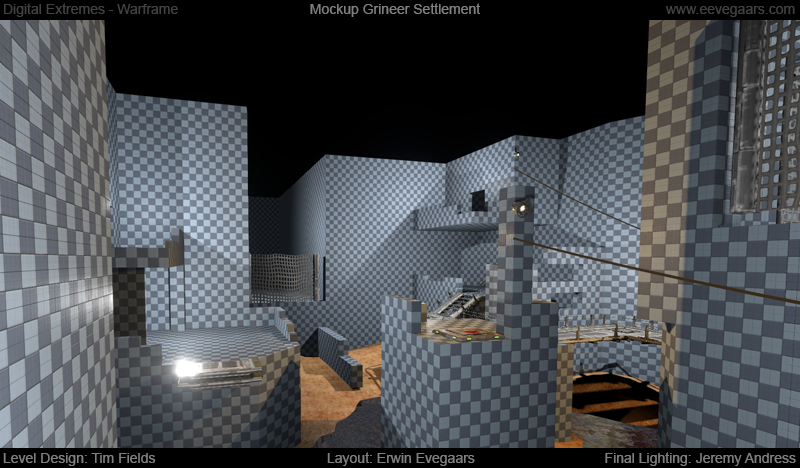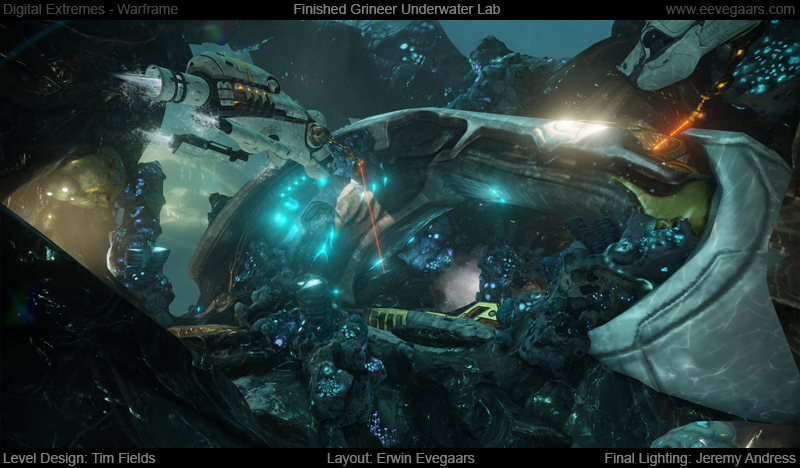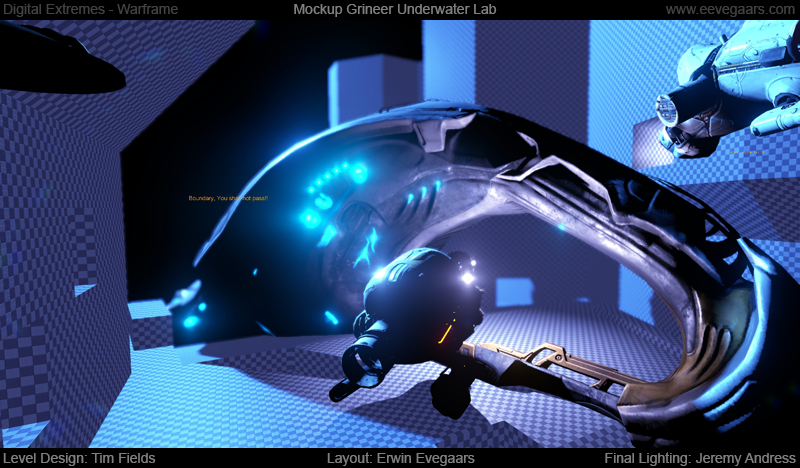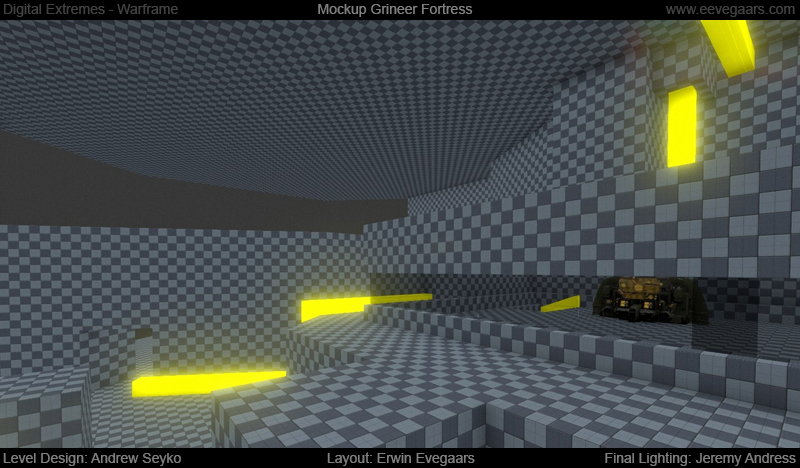In good communication with a Level Designer and the Art Director I was responsible for the artistic layout composition in the assigned videogame environments. This was done by creating life in an otherwise static mockup by telling stories using a visual medium. All the while ensuring it is in line with any technical constraints and artistic direction.
All shown images except Duviri include both a first and second pass lighting and effects done by my hand. Most of the end-results received a final pass done by a designated lighting- and effects-artist. However my original setup was often respected and merely polished. There are some cases where I ended up doing the final lighting and effects as well, such as the Infested Orokin tileset.
Over the years I've had the pleasure and honor of working with a lot of talented people from all kinds of departments. Making videogame environments is a team effort and I couldn't have achieved the results shown below without the support and cooperation of all these wonderful members that were involved in the making of this content. Every now and then I added names below the images. Those I worked with very closely during each project or specific image shown below. However there are many more involved to get this project done and I am grateful and honored to have had the chance to work with each and every one of them.

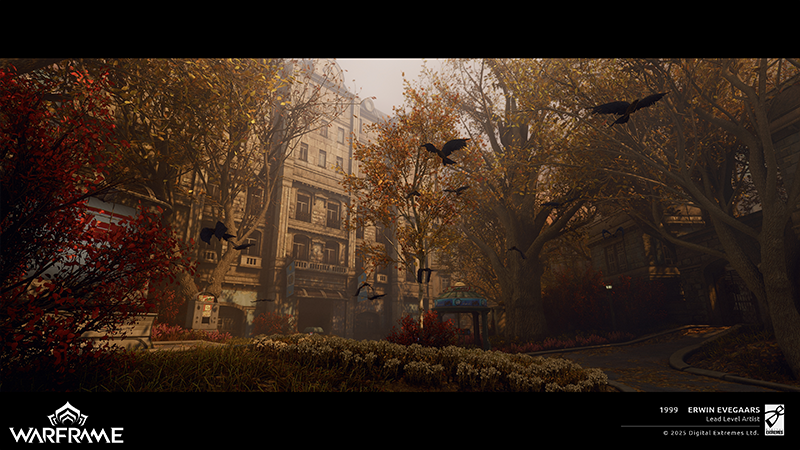
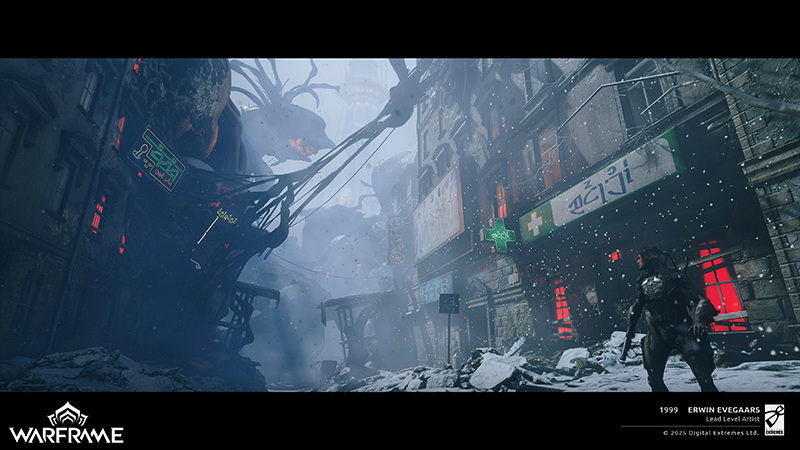
This was done using lots of individual kit pieces that were eventually randomly assembled using Houdini.Think wall pieces, window pieces, rooftop pieces, balcony attachments, etc. Once that was all working out well we started testing it on Warframe characters. This resulted in some changes to the scenery such as building height, ways to close off streets, doorways and other things that might not otherwise be as realistic in order to keep the gameplay fun and contained as possible.
The team had a blast working on something more grounded for variation. All the while still putting our own Warframe spin on it with infestation, alternate military presence and time traveling.
Level Designers I worked with directly: Mike Janes, Max Tishakov, Lisa Nguyen, Jordan Koehler, Bobby Mann, Nic Phan, Dave Cambell.
Technical Art: Milton Pangourelias and Kyle Davis who helped us setting up all the Houdini systems for the city and seasons.
Cem Cermen from Tools team for making the seasons work, all the added performance optimisation and general Editor support.
And last, but not least Derek Patterson, Jeremy Andress and Jongin Na from the Lighting department.


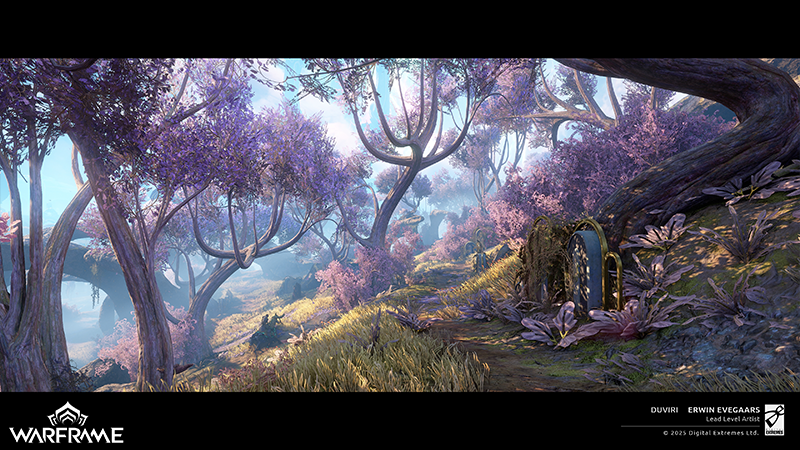
For
Duviri I started out doing research and development on all the natural
related thematics while in constant communication with both the Art Director
as well as the Environment Art team who were making the objects I needed.
On a 100x200m space I tested out both foliage growth and rock formations
on multiple environments, ranging from meadows and gardens to forests
and swamps. Once approved they would first get automatically applied using
a scatter system so we could cover and test large environments for gameplay,
visuals and performance. Later I would go back and adjust most of these
placements for optimal story telling and compositional results that best
matched my initial tests.
I ended up doing foliage and rock placements as well as dirt roads and
hiking trails on all 3 main islands, the Amphitheatre island and the Fractal
Pasture in the Undercroft. Last but not least, I set up little story telling
elements such as patio-tables, plant-clusters, stable-tools, blacksmithing
locations, and lounging areas that we could then spread throughout the
world. During the entire development of this set I worked very closely
with Level Designers Mitch Gladney and Kol Crosby, Milton Pangourelias
from Tech Art, Cem Cermen from Tools Team, Derek
Patterson for Lighting and Stephen
Fitzsimmons from Environment Art who delivered all the trees and bushes.
You all were an absolute delight to deal with, as always.
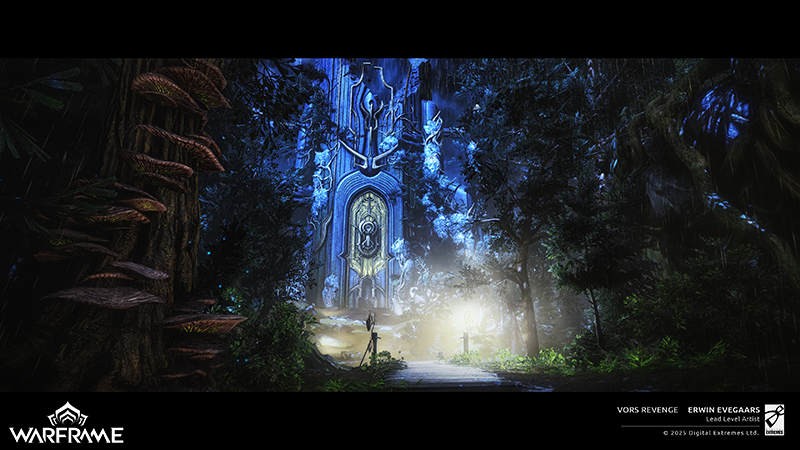


This quest-line was created
to replace our former
tutorial level. It was acompanied with a pre-rendered cinematic introduction
followed up with further ingame cutscenes. When the tutorial starts, all
the early environments were put together entirely by me; both Level art
and most of the general Level Design, exluding the tutorial specific parts.
Jeremy Andress for original lighting pass, Derek
Patterson for later applying the new lighting technology.
It was made using a mix of existing props from the game and new ones for
which I created proxies to have something to work with while environment
art finalized them. Proxies included large seqoia inspired trees and their
roots as separate pieces. Also structural debris for the Orokin ruins
and background cards for trees. Several other pieces were reused from
the Plains of Eidolon, Cetus, Venus and Grineer Forest.
Several smaller environments towards the end were reused from the Grineer
Forest set and enchanced to match both quality and story telling of the
questline. This helped save a lot of time considering it was made with
a very small team, which we could then use to prioritize the much larger
first half of the quest.
Driftercamp was part of
the New War update and included a boss battle and afterwards a safe space
to hang out and customize.
This was a whole new environment meant to become the home of the Drifter
character. Almost everything was reused from other sets such as Plains
of Eidolon, Cetus, Venus, Grineer Forest and New User Experience. Having
this not be part of a procedural system gave me more freedom and the oppertunity
in creating a larger environment that suited the story we were trying
to tell. The main challenge was that this level would be available directly
from the menu. This required it to have minimal loading time and therefore
keeping it very low on memory use.
The Level Design was done by Andrew
Seyko, I highly recommend visiting his page if you'd like to see some
early progress images.
Original final lighting was done by Jeremy Andress with Derek
Patterson later applying the new lighting technology.

Dagath Dojo was a brief project with a lot of thematic freedom. The room was meant to house a Warframe that at the time wasn't made yet outside of concept and there was no script either. The only requirements were to give it a horror/halloween thematic, stick to the Dojo metrics, needed a place for said Warframe character and as well a stable for horses of any kind.. It was up to me to decide how to explore this and where to go from there.
Being a big fan of medievil architecture and knowing horses would have some sort of role I chose to go with an crusader-inspired chapel. For the basic architecture I took most inspiration from existing chapels, churches and tombs from that era. Furthermore I took to movies such as Kingdom of Heaven, Interview with a Vampire, Sleepy Hollow as well as the classic monster movies from the 30's. Most of those may not have had a medieval thematic, but were a great inspiration for theatric and dramatic atmosphere. To build the basic structure I reused pieces from the old Grineer Settlement. The additional pieces that added detail and patterns on the floor are Orokin and so are the pieces I used for the chandeliers, which were originally used in entirely different ways and sizes.. The only new additions are the tomb itself, the banners, masks and the stable accessoiries. Final lighting was done by Jeremy Andress, whom I worked closely with in getting the desired outcome.

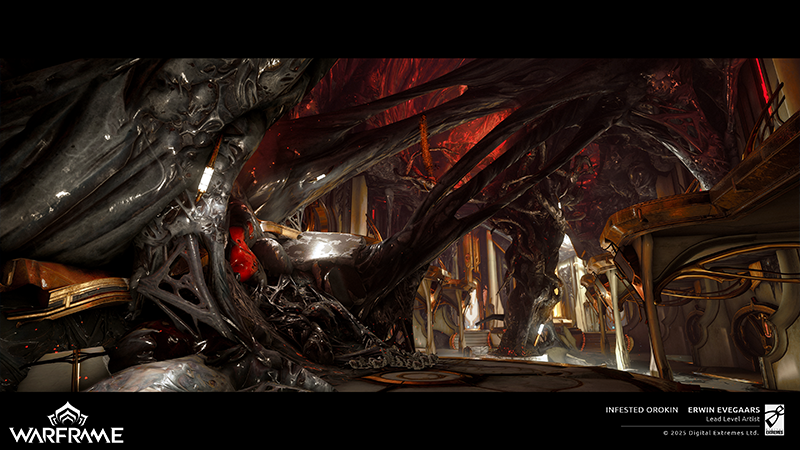

This set was part of the Call of Tempestarii Railjack update we released. An area that was mostly there to allow people to explore the derelict towers in the area which at times could be linked to quest-lines surrounding the dedicated Railjack experience. As the set is fairly small and contained, most of the Level Art, lighting and effects placement were all entirely done by me. While I used some existing Orokin rooms as a start-off point, applying an infested pass on them often resulted in an entirely different level. This is because I wanted to make it a unique experience to see the architecture in this state. There are as well some levels, such as shown in the first and third image above, that were created entirely from scratch by me.
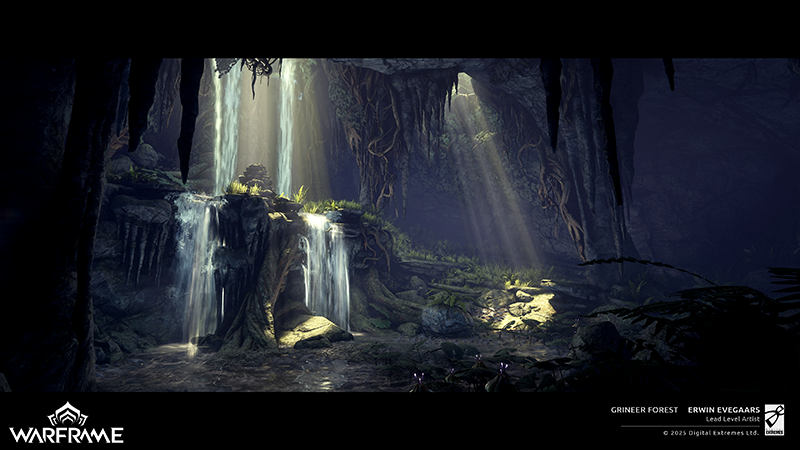


I was on the forefront of
Grineer Forest as well as leading the charge on the Remastered version
of this set a couple years later with Sebastian Spatzek as Level Designer.
We started with creating proxy pieces such as trees and rocks and a cave
kit. This was followed by creating beautiful corner prototypes that matched
the art direction and set a visual example and guideline for the rest
of the team. The level in the first image had its Level Design created
by Ben Edney. The other two were my own creation, with navigational and
gameplay pass from the Level Design department.
The remastered version included all new materials, sounds and lighting.
From a Level Art standpoint I went through each and every level to look
for improvements and consistency between all the individual levels. Think
material usage on buildings, railings and cover, but also redoing entire
sections if they could be done cleaner or had space for visual improvement
and upgrades to better match the desired outcome.
There were also some technical advances made in between the original set
and the remastered version such as the foliage system. This allowed me
to not only learn and then apply this to the level, but as well teach
my peers how to use them. This technology would later be improved upon
further and applied to the Plains of Eidolon.

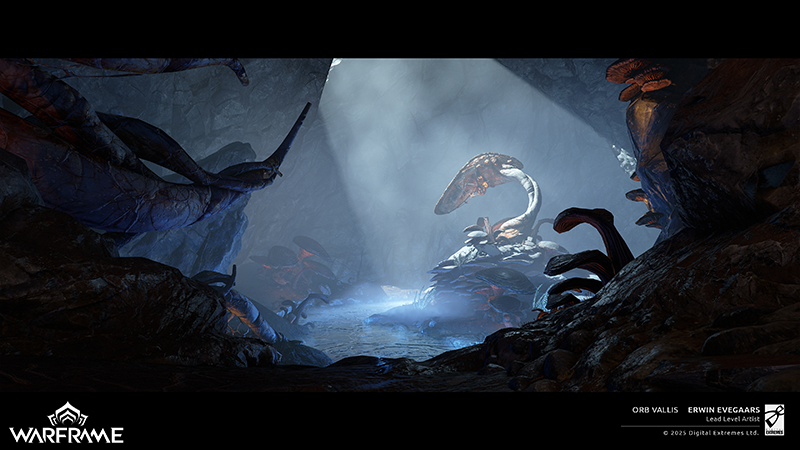

For Orb Vallis I worked
directly with Kol Crosby as the Level Designer and was co-responsible
for Level Art in all the Caves with Mitch Gladney. Outside of the caves
I also did two large craters that can be found on the surface.
To quickly and efficiently build Level Art for all these caves with just
the two of us, I designed a cave-kit that could comfortably follow all
the Level Design needs without too much kit-bashing. This could then be
dressed up with a more detailed pass to get interesting and unique compositions.
This kit included pieces such as straight, corner, 3-way, fourway, entrance
and cap which could all comfortably be used upright, upside down, facing
each other in a mirrored way and combined with terrain to give us the
most versatile results. This kit would later be reused for New User Experience
among other areas. The glowing coolant and mushrooms, often the highlights
of our caves, were prototyped by myself and finalized by the talented
Arif
Pribadi.
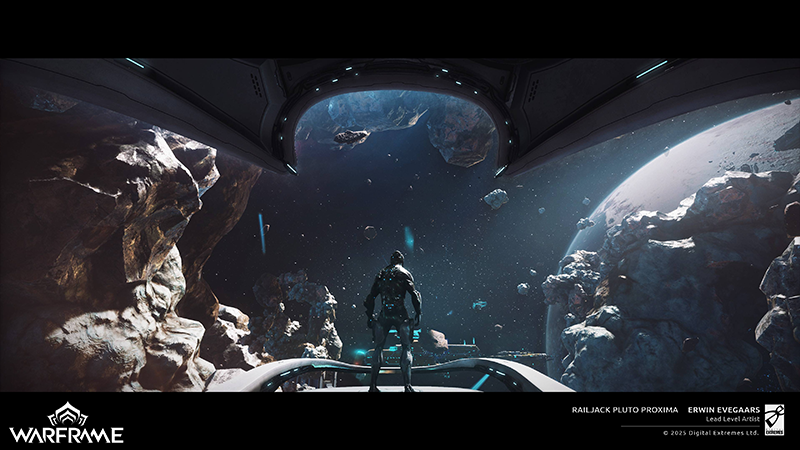
The last update came with 'Call of the tempestarii', which included two new planet regions, or Proximas; Neptune and Pluto.
What Level Artists such as myself generally do here is create clusters of themed compositions that will then get generated along a Spline which the Railjack will follow to sucesfully complete their mission. Pluto was special in its own way because instead of just having a planet in the background, we added a smaller planet, or asteroid, that you will go straight through instead. This was done by adding a story that the Corpus was mining the surface like an apple, slowly eating their way inwards. This was causing it to have large chunk removed with lots of floating debris around it. Said debris are the compositions I put together using the sculpted work of the talented Arif Pribadi. He and I also worked closely together on testing the planet shape to get the best results for both gameplay and visual impression.


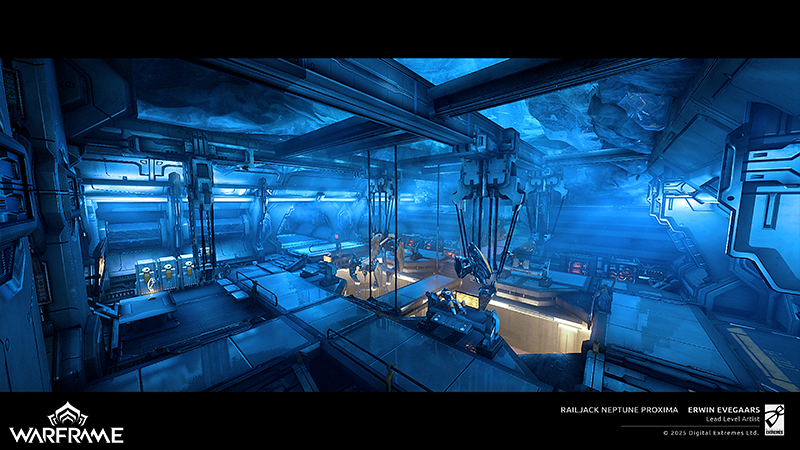
It's a very small, self contained tileset with only a handful of spaces consisting of connectors, caps, intermediates, spawn and exit.
All the Level Art was done by me, using a mix of Corpus Ship set pieces and the ice kit from Orb Vallis. Originally these ice pieces had a much bigger role for that set, but due to time constraints were reduced to only a singular cave. Since the pieces were already prototyped, tested and finished, it made sense to reuse.
Before and after comparisons
The images
below are acompanied by a screenshot of the mockup showing how I often
received the original Level Design.
The level designers focus on the gameplay path and pacing of the level.
I will then visualize this to the desired art direction of the set by
using set pieces created by the Environment Art team.



